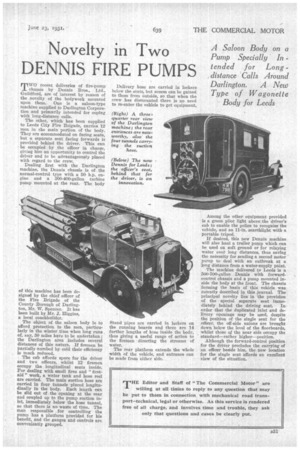Novelty in Two DENNIS FIRE PUMPS
Page 45

If you've noticed an error in this article please click here to report it so we can fix it.
TWO recent deliveries of fire-pump • chassis by Dennis Bros., Ltd., Guildford, are of interest by reason of the novelty of the bodywork mounted upon them. One is a saloon-type machine supplied to Darlington Corporation and primarily intended for coping with long-distance calls.
The other, which has been supplied to Leeds City Fire Brigade, carries 12 men in the main portion of the body. They are accommodated on facing seats, but a separate seat facing forwards is provided behind the driver. This can be occupied by the officer in charge, giving him an opportunity to control the driver and to be advantageously placed with regard to the crew.
Dealing first with the Darlington machine, the Dennis chassis is of the normal-control type with a 50 h.p. engine and a 300-400-gallon turbine pump mounted at the rear. The body
of this machine has been designed by the chief officer of the Fire Brigade of the County Borough of Darlington, Mr. W. Spencer. It has been built by Mr. J. Higgins, a local ceachbuilder.
The object of the saloon body is to afford protection to the men, particularly in the winter time when long runs of, say, 30 miles have to be undertaken; the Darlington area includes several distances of this nature. If firemen be partially numbed by cold their efficiency is much reduced.
The cab affords space for the driver and two officers, whilst 12 firemen occupy the longitudinal seats inside. For dealing with small fires and " firstaid " work, a water tank and hose reel are carried. The main suction hose are carried in four tunnels placed longitudinally in the body. Each length can be slid out of the opening at the rear and coupled up to the pump suction inlet, immediately below the hose tunnel, so that there is no waste of time. The man responsible for controlling the pump has a platform provided for his benefit, and the gauges and controls are conveniently grouped.
Delivery hose are carried in lockers below the seats, but acoess can be gained to them from outside, so that when the crew has dismounted there is no need to re-enter the vehicle to get equipment.
stand pipes are carried in lockers on the running boards and there are 14 further lengths of hose inside the body, thus giving a useful range of action to the firemen directing the streams of water.
The rear platform extends the whole width of the vehicle, and entrance can be made from -either side.
Among the other equipment provided is a green pilot light above the driver's cab to enable the police to recognize the vehicle, and an 11-in, searchlight with a portable tripod.
If desired, this new Dennis machine will aLso haul a trailer pump which can be used on soft ground or for relaying water over long distances, thus saving the neeessity for sending a second motor pump to deal with an outbreak at a long distance from a water-supply point.
The machine delivered to Leeds is a 500-700-gallon Dennis with forwardcontrol chassis and a pump mounted inside the body at the front. The chassis forming the basis of this vehicle was recently described in this journal. The principal novelty lies in the provision of the special separate seat imme diately behind the driving seat. In order that the duplicated inlet and delivery openings may be used, despite the position of the single seat for the officer, the off-side unions are brought down below the level of the floorboards, whilst those of the near side occupy the standard—rather higher—position.
Although the forward-control position for the driver precludes the carrying of an officer beside him, the new location for the single seat affords an excellent view of the situation.




























































































